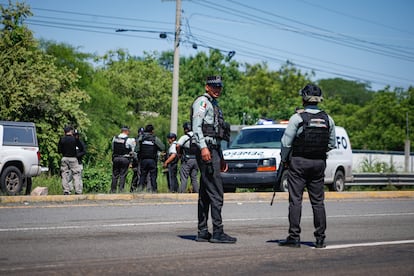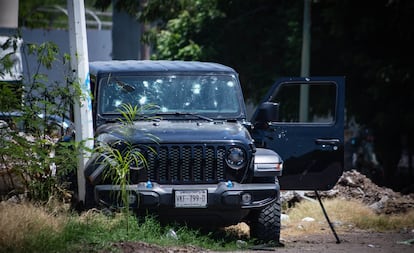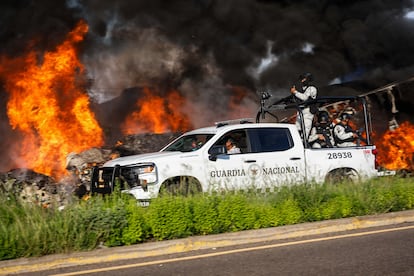Violence spreads in Mexico amid fears Los Chapitos and El Mayo faction have ended truce
Experts and local media blame the recent clashes on divisions within the Sinaloa Cartel. At least three people have been reportedly killed

A new wave of violence has raised fears in the Mexican state of Sinaloa, where there is concern that Los Chapitos — a cartel led by the sons of the notorious drug trafficker Joaquín “El Chapo” Guzmán — and the armed group led by Ismael “El Mayo” Zambada — the co-founder of the Sinaloa Cartel — have ended their truce.
The alarm follows shootouts, attacks on military convoys and the discovery of two dead bodies in Sinaloa. On Tuesday, Mexican President Andrés Manuel López Obrador said that “it is very possible” that the violence is related to the July 25 arrest of El Mayo in the United States. The president called for calm and said that there are enough forces from the Army and the National Guard “to prevent the gangs from clashing.”
“I don’t want to advance anything,” said the president when asked if there was a divide in the Sinaloa Cartel. Despite the silence of the authorities, security analysts and local media have little doubt that the escalating violence in the city of Culiacán and other areas of Sinaloa is linked to the clash between La Mayiza and La Chapiza, the two main factions in the Sinaloa Cartel.
The first warning was a shootout between members of the Armed Forces and “armed civilians” — the term used by Mexican authorities to avoid speaking explicitly about criminal groups. According to the official version of events, an Army convoy encountered a cartel cell in the La Campiña neighborhood, east of Culiacán, early Monday morning. López Obrador confirmed the death of a sergeant a day later. He was one of two soldiers who were injured in the shootout.
The shooting in La Campiña made national and international headlines, but the violence also extended to the south of Culiacán and to other nearby communities. Around 9 a.m., another clash took place between an Army patrol and armed civilians on the Mexico 15 highway, an area controlled by El Mayo’s faction. The confrontation left one dead, according to information verified by the newspaper Noroeste. A couple of hours later, there was another shooting in the municipality of Costa Rica. Governor Rubén Rocha confirmed that two civilians were injured in the attack.

In the afternoon, the situation worsened in other areas of Culiacán. In the town of Portaceli, one man was found dead and another was wounded. Authorities also found a torched vehicle. The body of another person, who had been handcuffed and murdered, was abandoned on Agricultores Boulevard. Another victim died from a gunshot wound in Culiacán 87 park. Authorities also seized several vehicles following shootouts between civilians and military personnel in the El Salado area of Culiacán, and clashes between civilians and National Guard agents on Highway 20, near the city of Navolato and Costa Rica.
Violence also hit the municipality of Elota, where classes at all educational levels were suspended on Tuesday, and stores and businesses were advised to adopt security measures. The Autonomous University of Sinaloa, which has 70,000 students, announced that classes would be held virtually until further notice “as a preventive measure in light of the violent events that have occurred in Culiacán, Badiraguato, Navolato, Elota and Eldorado.” However, the Sinaloa education department resumed classes in Culiacán after suspending them on Monday. State government agencies announced that public schools are operating “normally.” Authorities also announced that public transportation had been fully restored.
The death toll from the wave of violence has not been confirmed, with local media reporting different figures. Revista Espejo reported that at least three people dead. Noroeste confirmed that there were five dead, while Los Noticieristas, El Debate and the weekly newspaper RíoDoce chose to report on each incident separately, without providing an overall death toll.
The Sinaloa state government has so far only confirmed the murder of the person who was found dead on the Mexico 15 highway. It also reported that one arrest had been made and that a dozen vehicles had been seized by authorities, and another dozen stolen. The state prosecutor’s office has not issued any statement about the number of people killed or injured, focusing instead on urging the community to report all robberies.
Governor Rocha described the situation in Culiacán as “calm” at a press conference on Monday. The next morning, he posted a video on social media, in which he is seen walking along the banks of the Tamazula River and insisting that everything is under control.
But according to Revista Espejo, the Sinaloa Cartel is on the brink of splitting in two. Other local journalists who spoke to EL PAÍS agreed with this assessment.

Security analyst Alfredo Brambila says that violence is “out of control.” He argues that the stability authorities have boasted of in recent years has been sustained by a “narco peace,” which is now under threat following the allegations that El Chapo’s son Joaquín Guzmán López handed over El Mayo to U.S. authorities. El Mayo was arrested alongside Guzmán López in July, but there are varying accounts of how the capture took place.
“The violence is the result of a rupture between the main criminal groups of the Sinaloa Cartel, Los Mayos and Los Chapitos,” says Brambila, who argues that the El Mayo fraction is looking for “revenge,” while Los Chapitos want to capitalize on the apparent weakness of their former partners after the fall of El Mayo.
David Saucedo, an organized crime specialist, says that although the leaders of the two factions have issued no formal declaration of war, there is evident friction between the cartel members. “Authorities are on the back foot, and the criminal groups are setting the tone,” he says. “These are signs of what appears to be the start of a war, although we have not yet seen an open confrontation.” Seven weeks after El Mayo was captured, there are growing fears that his supporters will try to settle the score.
Saucedo points to signs that may be behind the latest clashes: the murder of a dozen La Mayiza operators at the hands of Los Chapitos, shootouts with security elements suspected of collaborating with El Chapo’s sons, and Zambada’s exhortation to his men to avoid violence in the “border zones,” where members of different factions are present. “Declaring war from one day to the next was reckless,” says the specialist. “They took this time to accumulate weapons, ammunition, and men.”

The Sinaloa Cartel is facing a strategic dilemma: start an internal war or maintain unity to confront its rivals. This week, for example, members of the Sinaloa Cartel clashed with groups linked to the Juarez Cartel in Ojinaga, Chihuahua. Authorities reported four deaths.
The Mexican government has reinforced security in Sinaloa, deploying hundreds of soldiers from other regions of the country — which has been key to deterring the violence of recent weeks. “There are enough elements to maintain peace and tranquility and so far, fortunately, things are calming down,” said López Obrador. “Sinaloa does not deserve violence,” the president concluded, in a new call to criminal groups to avoid new confrontations.
Sign up for our weekly newsletter to get more English-language news coverage from EL PAÍS USA Edition
Tu suscripción se está usando en otro dispositivo
¿Quieres añadir otro usuario a tu suscripción?
Si continúas leyendo en este dispositivo, no se podrá leer en el otro.
FlechaTu suscripción se está usando en otro dispositivo y solo puedes acceder a EL PAÍS desde un dispositivo a la vez.
Si quieres compartir tu cuenta, cambia tu suscripción a la modalidad Premium, así podrás añadir otro usuario. Cada uno accederá con su propia cuenta de email, lo que os permitirá personalizar vuestra experiencia en EL PAÍS.
¿Tienes una suscripción de empresa? Accede aquí para contratar más cuentas.
En el caso de no saber quién está usando tu cuenta, te recomendamos cambiar tu contraseña aquí.
Si decides continuar compartiendo tu cuenta, este mensaje se mostrará en tu dispositivo y en el de la otra persona que está usando tu cuenta de forma indefinida, afectando a tu experiencia de lectura. Puedes consultar aquí los términos y condiciones de la suscripción digital.
More information
Archived In
Últimas noticias
There is as much life left to discover on planet Earth as that which is already known
Dozens presumed dead, around 100 injured in fire at Swiss Alps bar during New Year’s celebration
Is porn for women different from conventional porn? We spoke to those who make it
Cartagena de Indias is sinking: What can the city do to mitigate it?
Most viewed
- Sinaloa Cartel war is taking its toll on Los Chapitos
- Reinhard Genzel, Nobel laureate in physics: ‘One-minute videos will never give you the truth’
- Oona Chaplin: ‘I told James Cameron that I was living in a treehouse and starting a permaculture project with a friend’
- David King, chemist: ‘There are scientists studying how to cool the planet; nobody should stop these experiments from happening’
- Why the price of coffee has skyrocketed: from Brazilian plantations to specialty coffee houses











































